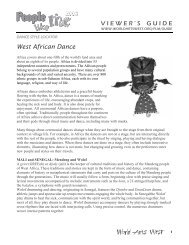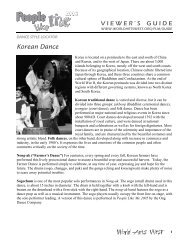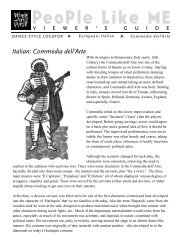South African: Gumboot dance - World Arts West
South African: Gumboot dance - World Arts West
South African: Gumboot dance - World Arts West
You also want an ePaper? Increase the reach of your titles
YUMPU automatically turns print PDFs into web optimized ePapers that Google loves.
V I E W E R ’ S G U I D E<br />
W W W. W O R L D A R T S W E S T. O R G / P L M / G U I D E<br />
DANCE STYLE LOCATOR<br />
Related Topics: Plate Tectonics and Geological Time<br />
Visit our online Viewerʼs Guide for images of all below maps and see an animation at<br />
www.worldartswest.org/plm/guide/locator/tectonics.shtm<br />
MAP 1<br />
Precambrian<br />
The widely accepted theory of Plate Tectonics claims that the continents have been colliding and splitting<br />
apart since the beginning of Earthʼs history. The outer layer, or crust, has been shifting and moving,<br />
changing the formations of the continents and oceans, due to movement of various under layers of the<br />
earth.<br />
Based on studies of the oldest rock and sediment formations, the earliest maps of earth are still only<br />
guesses of how the continents looked in the late Precambrian Eon, about 665 million years ago. During<br />
the first 4 billion years of the Earthʼs history, the building blocks to complex life existed but had not yet<br />
developed. Scientists believe that continents came together and split apart several times into “supercontinents.”<br />
MAP 2<br />
Early Triassic<br />
The most recent supercontinent is called “Pangaea,” which means “all land,” and was formed 200 million<br />
years ago. Fossils show that plant and animal life traveled throughout Pangaea before it split apart<br />
and turned into our formation of continents today.<br />
MAP 3<br />
Late Jurassic<br />
During the time of the dinosaurs, Pangaea started to break up into pieces, but since it was such a slow<br />
process, you can see that North America had separated from <strong>South</strong> America, but was still connected to<br />
Europe. The <strong>South</strong>ern continents were still joined into a large continent called “Gondwana.”<br />
MAP 4<br />
Late Cretaceous<br />
The southern continent of Gondwana started to break up, separating <strong>South</strong> America, Africa, and<br />
Antarctica. Australia was still connected to Antarctica but beginning to move northward. India separated<br />
from Madagascar and raced northward at a continental speed record of 15-20 centimeters per year!<br />
13











